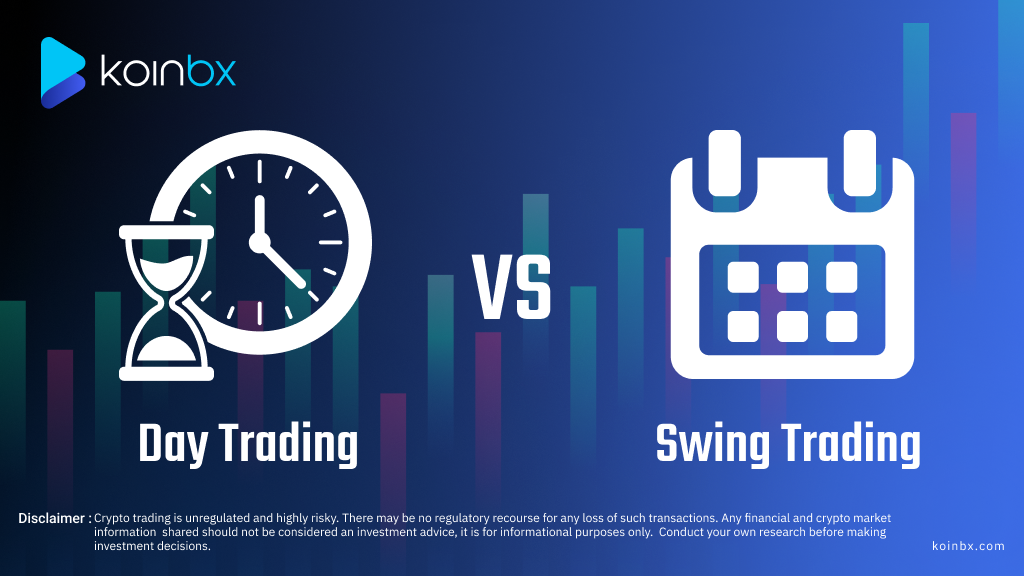Introduction
Are you into crypto trading? You have likely come across swing trading and day trading—two of the most talked-about strategies. Each of them offers unique paths to potential profits. But how do you decide which approach suits you best?
Think of them as two different approaches to the same goal—turning market movements into profits. Picking the right one can shape your trading journey, whether you are just starting out or already have some experience under your belt.
In this guide, we’ll dive into the essentials of day trading and swing trading, unpacking their pros and cons, and what you need to consider before choosing your path. Ready to explore and find the best match for your trading goals? Let’s get started!
What is Day Trading?
Day trading is all about making quick moves in the market. Day traders buy and sell assets within the same day, aiming to profit from small price changes. Their goal is to take advantage of intraday price movements and close all positions by the end of the trading session.
Characteristics of Day Trading
Day Trading is all about working within very short timeframes, often focusing on minute-by-minute or hourly price movements. This fast-paced strategy requires traders to open and close their positions within the same day, avoiding overnight risks entirely. To succeed, day traders must be quick decision-makers, adept at analyzing real-time data and market dynamics. The goal is to capitalize on intraday volatility, but this also demands intense focus and constant monitoring of market trends throughout the trading session.
Advantages of Day Trading
Potential for Quick Profits: Traders can benefit from frequent, small price movements.
Avoids Overnight Risks: Since positions are closed daily, there’s no exposure to market events after hours.
High Activity: The fast-paced nature keeps it exciting and engaging.
Disadvantages of Day Trading
High Stress: Constant monitoring and decision-making can be mentally draining.
Time-Consuming: Requires full-time focus and significant market analysis.
Risk of Losses: Volatility in the crypto market can lead to rapid losses.
Skill-Intensive: A deep understanding of technical analysis and market trends is essential.
Also read : What Are Governance and Utility Tokens? How Do They Work?
What is Swing Trading?
Swing trading is a strategy that focuses on capturing gains from price movements over days, weeks, or even months. Swing traders aim to buy low and sell high, taking advantage of broader market trends.
Characteristics of Swing Trading
Swing Trading operates over a longer timeframe, typically days, weeks, or even months. It revolves around capturing short- to medium-term price swings by analyzing market trends and chart patterns. Swing traders rely heavily on technical indicators, historical price data, and support and resistance levels to predict potential market movements. This strategy allows for more flexibility and less screen time compared to day trading, making it a popular choice for those who can’t dedicate their entire day to trading.
Advantages of Swing Trading
Time Flexibility: You don’t have to stay glued to your screen all day.
Potential for Bigger Gains: Capturing larger price swings over time can yield substantial profits.
Reduced Stress: A less frantic pace compared to day trading.
Disadvantages of Swing Trading
Overnight Risk: Open positions are exposed to market events outside trading hours.
Discipline Required: Success depends on sticking to a trading plan and managing emotions.
Learning Curve: Understanding technical analysis and chart patterns takes time.
Swing vs. Day Trading: Which is Better & Safer?
Both strategies have their pros and cons, so the “better” choice depends on your lifestyle, skills, and risk tolerance.
1. Day Trading is ideal for those who can dedicate their full attention to the market and thrive in fast-paced environments. It’s better suited for experienced traders with a larger capital base and a high tolerance for stress.
2. Swing Trading works well for part-time traders or those who prefer a more relaxed pace. It’s less demanding and allows time for thoughtful decision-making.
3. Day trading minimizes overnight risks but requires quick actions to minimize intraday losses.
4. Swing trading offers more time to evaluate trends but is vulnerable to unexpected overnight market events.
In general, swing trading might be safer for beginners due to its less stressful nature and lower time commitment. However, day trading can be rewarding for those who master its demands.
Also read : Top 10 Cryptos to Invest in January 2025
Bottom Line
Day trading and swing trading are like two different tools in a trader’s toolbox. Choosing the right one depends on your time availability, risk tolerance, and trading goals. If you enjoy quick action and have time to dedicate, day trading might be your style. If you prefer flexibility and a more laid-back approach, swing trading could be the way to go.
Remember, success in either strategy requires discipline, patience, and continuous learning. Explore these options, start small, and find what fits your risk appetites and goals.
Download KoinBX Android App | Download KoinBX iOS App
Disclaimer: Any financial and crypto market information shared should not be considered investment advice. It is for informational purposes only. Conduct your own research before making investment decisions. Crypto trading is unregulated and highly risky. There may be no regulatory recourse for any loss of such transactions.






Comments